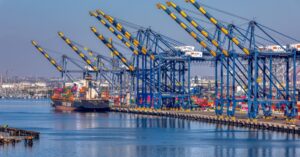It would be nice if companies could always economize by using standard freight services and never take a hit for the extra cost of expedited shipping. But here in the real world, expedited freight is more expensive but often necessary. It can be a valuable tool when delivery timelines shrink for a variety of reasons.
What it comes down to is balancing cost versus speed in shipping decisions and overall transportation strategy. Shippers need to analyze that tradeoff through a matrix of various factors particular to their situation and come up with the best solution that meets their business objectives.
Expedited Freight vs. Standard Shipment Processes
B2B expedited shipping is often used to prevent production stoppages, such as line-down events in manufacturing, ensuring delivery of time-critical parts and raw materials. Expedited transit times are about one to three business days. The industries that rely most heavily on expedited freight include automotive manufacturing, pharmaceuticals and healthcare, food and beverage, technology and electronics, and energy and utilities.
Standard shipping is sufficient for non urgent deliveries such as replenishing stocks or for large bulk shipments where cost efficiency is the top priority. Depending on the country, distance and choice of provider, it typically takes three to seven business days or more.
As B2B freight typically involves larger, more complex shipments (pallets or full truckloads), cost per unit is a significant consideration. Expedited freight might involve booking dedicated freight services and/or using specialized equipment.
Expedited freight works by optimizing shipping routes, leveraging faster modes of transportation and bypassing logistical steps that standard shipments undergo. This may involve exclusive use of a vehicle and prioritized freight handling.
Direct Shipping Routes: Expedited freight often uses point-to-point shipping, avoiding multiple stops or distribution hubs that standard shipments typically pass through. This minimizes handling and reduces transit time.
Dedicated Transport: Shipments often have dedicated trucks or planes so there’s no consolidation or intermediate transfers with other goods. Standard freight usually involves load sharing and multiple transfers, which add logistical steps and time.
Priority Handling: Expedited shipments are given priority at warehouses, customs, or logistics hubs for faster processing. Standard shipments are processed in sequence, which slows down transit times.
Simplified Supply Chain: Expedited freight avoids unnecessary steps like warehousing or extended sorting, as freight moves directly to its final destination.
Faster Transportation Modes: Air freight, expedited ground services, and other methods replace slower modes like ocean freight or standard trucking.
When to Choose Expedited Freight
While “expedited” is often associated with “expensive” shipping, consider the costs that can come from an overreliance on standard freight services. There’s a risk of late deliveries holding up manufacturing, increasing back orders, or causing a missed customer deadline. In the case of pharmaceuticals and healthcare, lives are at stake if critical supplies don’t arrive on time. In automotive manufacturing, a line going down can cost thousands of dollars per minute and create ripple effects across the manufacturers supply chain as production is rescheduled. Not to mention the damage to the supplier’s reputation for the failure to meet delivery schedules.
Understanding shipment priorities is key to making informed decisions. You need to evaluate whether the urgency of delivery justifies the higher cost of expedited freight or if standard shipping aligns better with timelines and budget.
Other scenarios in which the speed of expedited outweighs the costs include meeting the growing OTIF requirements of retail customers and handling shipments of emergency supplies.
The COGISTICS Transportation Difference
COGISTICS Transportation ensures secure, streamlined expedited freight services. As time sensitivity becomes paramount, complex challenges can hinder efficient operations. COGISTICS Transportation becomes your go-to expedited partner, with a robust carrier network, advanced technology, and 24/7 on-demand availability.
Clear communication needs to happen during the planning stages of your work with a logistics provider. There are many important details to cover, from order volumes to shipment destinations, carrier pricing and budgeting, and freight booking. Every step of the way, COGISTICS Transportation lays out what to expect and works in a highly collaborative, consultative manner to help you map out an effective transportation strategy.
Aligning Service Levels With Business Objectives
In each case, deciding between expedited and standard freight depends on careful consideration of business priorities, customer demands, budget constraints, and service options. By analyzing and weighing all these factors, businesses can tailor a balanced transportation plan that meets all their objectives.
COGISTICS Transportation excels in guiding shippers through this process, delivering efficient, reliable solutions for every freight challenge. Whatever your demands, our expedited freight services and communication plan are there to back you up. We’re both high tech and high touch, with real-time tracking and notifications plus the hands-on approach of a family-owned business, including phone availability. COGISTICS Transportation is also a member of the global logistics partnership network WCA, with access to more than 6,800 offices in 191 countries worldwide.
We provide personalized treatment anywhere on the globe, via land, air, and ocean freight operations. Each shipment is tracked from order to destination, and proactive communication is paramount. Let’s Talk.




